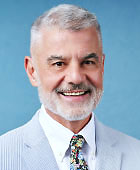Reflecting on the Legacy of Saul Levin, M.D., M.P.A., the Heart of American Psychiatry for the Past 10 Years

When Saul Levin steps down as the CEO and Medical Director of APA, it will be the end of an era—an era of change, growth, and greatness.
While I am happy to see a man who has become my friend move on to the next chapter of his life and career, I am sad to see a passionate and supportive colleague leave the role that has brought him and our Association such success (Psychiatric News “Levin to Step Down as CEO, Medical Director Next Year”).
APA has changed a lot since Saul assumed the role of Chief Executive Officer and Medical Director in 2013. These last 10 years have seen our Association rebrand into one of medical leadership for mind, body, and brain. From moving our headquarters back into the District of Columbia, the heart of government and advocacy in our nation, to spearheading the development and publication of DSM-5-TR, Saul has been a transformative agent for American psychiatry. The past few years have also seen APA have an honest reckoning with its problematic past and make a historic apology for its role in supporting structural racism in psychiatry. APA membership is changing as well. It has become more diverse in terms of race, gender identity, and geography, a change that the APA administration, under Saul’s leadership, is leaning into.
These big changes immediately spring to mind when I think of what has been accomplished at APA over the past decade. However, a particular hallmark of Saul’s tenure has also been a more subtle, but no less impressive, shift in how our Association engages with the public, our allies in the house of medicine, and the decision-makers at every level of our government. Today’s APA does not wait to react to the world around us but moves to make change in the medical landscape in which we operate. This shift in approach has fully brought APA into the 21st century and cemented us as a modern medical association with our eyes focused on a better future for our patients and our profession.
For my part, I could not have asked for a more supportive and thoughtful colleague with whom to collaborate during my time working with APA. Whenever I have spoken with him about an issue or idea I have had, I have always been met with support, out-of-the-box thinking, and inspiration to do better. No matter what I put in front of him, Saul will always utter four words: “How can I help?”
I think that says a lot about the man and the leader he is. ■



